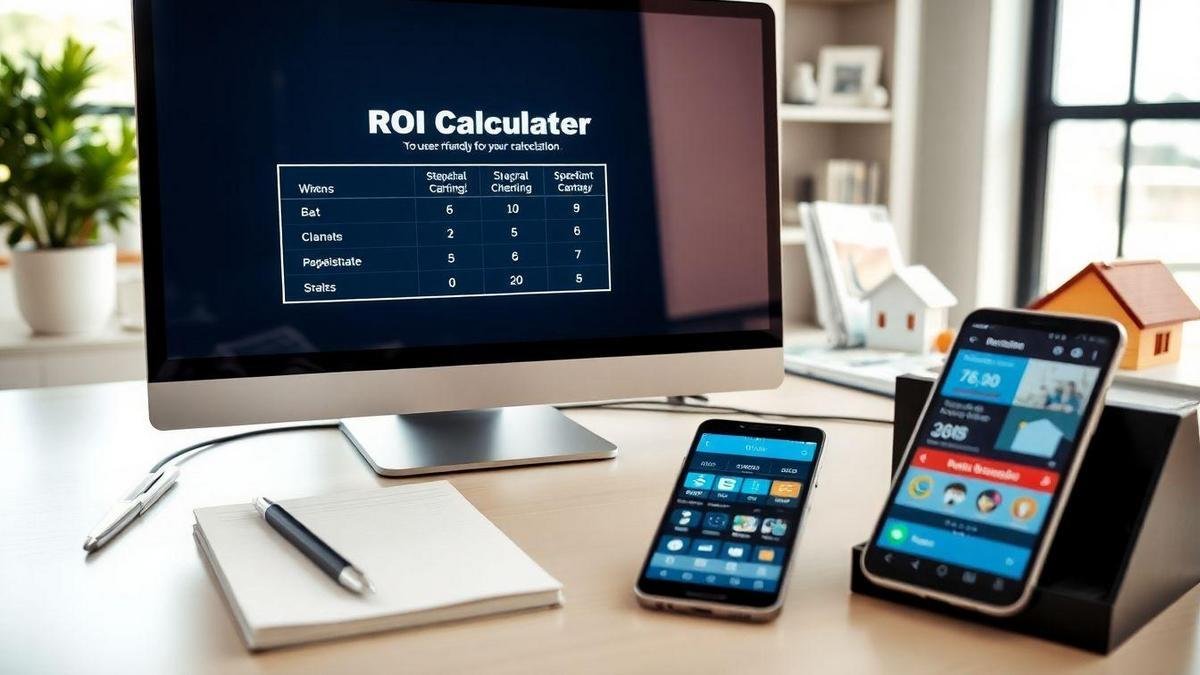Real estate marketing ROI measurement shows a clear way to prove value. It starts with the simple ROI formula and explains what counts as revenue and cost in property marketing. It covers setting crisp KPIs for leads, conversion rate, and cost per lead. It shows how to track direct and indirect marketing costs and link ad spend to closed deals. It explains first touch, last touch, and multi-touch attribution and when to use each. It guides building a compact dashboard with leads, CPL, ROI, and CLV. It finishes with simple tips to boost conversion, assign fair credit across channels, and pick the right tools and calculators.
- Set clear goals for every campaign.
- Track leads from ads to sales to see real ROI.
- Use cost per lead and cost per sale as key metrics.
- Test ads and shift budgets to top performers.
- Share results in simple reports for stakeholders.

Real estate marketing ROI measurement explained in one formula
Simple ROI formula: (Revenue – Cost) ÷ Cost
Understanding Real estate marketing ROI measurement boils down to a straightforward formula:
(Revenue – Cost) ÷ Cost
This formula helps professionals in the real estate market determine profit relative to their marketing investment.
What counts as revenue and cost in property marketing
In property marketing, revenue refers to the total income generated from property sales, including:
- Sale price of the property
- Any additional fees or commissions earned
Cost encompasses all expenses related to marketing a property, including:
- Advertising costs (online ads, print media)
- Staging expenses
- Photography and videography costs
- Real estate agent commissions
Quick example with a property sale
Consider a property sold for $300,000 with total marketing costs of $30,000. Using the formula:
- Revenue = $300,000
- Cost = $30,000
Plugging these numbers into the formula:
ROI = (300,000 – 30,000) ÷ 30,000
This simplifies to:
ROI = 270,000 ÷ 30,000 = 9
This means the return on investment is 9, or 900%, indicating a highly successful marketing effort.

Setting clear KPIs for property marketing ROI measurement
Lead volume, conversion rate, and cost per lead
In the real estate sector, setting clear Key Performance Indicators (KPIs) is essential for measuring marketing success. Three critical KPIs include lead volume, conversion rate, and cost per lead.
- Lead Volume: Total number of potential buyers or renters generated through marketing campaigns.
- Conversion Rate: Percentage of leads that turn into actual sales or rentals.
- Cost per Lead: Total cost of acquiring a lead, crucial for maximizing profit.
Time-bound and measurable KPI examples
Establishing KPIs with time-bound and measurable examples is vital. Here are a few:
| KPI | Description | Time Frame |
|---|---|---|
| Leads generated | Number of leads acquired through campaigns | Monthly |
| Sales conversion rate | Percentage of leads that resulted in sales | Quarterly |
| Cost per lead | Total marketing spend divided by leads | Monthly |
These examples create a clear picture of performance over time, allowing for adjustments as needed.
How they pick KPIs for each campaign
When selecting KPIs for a specific campaign, align them with campaign goals. For instance, if the aim is to increase brand awareness, focus on lead volume; if the goal is to boost sales, prioritize conversion rate.
Evaluate past campaign performance to identify effective KPIs. By analyzing data, tailor approaches to what works best for the audience, ensuring each campaign is set up for success.

Tracking Marketing Costs and Revenue for Accurate Real Estate Marketing ROI Measurement
Direct Costs vs Indirect Costs in Property Marketing
When analyzing property marketing, distinguish between direct and indirect costs. Direct costs are expenses directly tied to marketing efforts, including:
- Advertising fees: money spent on online ads, print media, or billboards.
- Promotional materials: costs for brochures, flyers, or signs.
- Photography and staging: expenses for professional photos or staging homes for sale.
Indirect costs are harder to pin down and can include:
- Staff salaries: wages for employees involved in marketing.
- Office expenses: rent, utilities, and supplies that support marketing efforts.
- Software subscriptions: tools used for marketing analytics or customer relationship management.
Understanding these costs helps accurately calculate Real estate marketing ROI measurement.
Linking Ad Spend to Closed Deals and Commissions
Tracking ad spend and linking it to closed deals is crucial. For example, if a real estate agent spends $2,000 on online ads and sells a property for $300,000, assess how many leads came from that ad spend. If the agent closes 5 deals from that spend, the ROI can be calculated as follows:
| Ad Spend | Closed Deals | Total Revenue | ROI Calculation |
|---|---|---|---|
| $2,000 | 5 | $300,000 | (Revenue – Cost) / Cost = (300,000 – 2,000) / 2,000 = 149.0 |
This table illustrates how spending translates into revenue, showcasing the effectiveness of marketing efforts.
Best Practices for Accurate Cost Tracking
To achieve accurate tracking, implement several best practices:
- Use Spreadsheets: Keep a detailed record of all marketing expenses in a spreadsheet for easy updates and adjustments.
- Employ Tracking Software: Utilize marketing tools designed for real estate to monitor ad performance and costs.
- Regular Reviews: Conduct monthly reviews of marketing expenses and outcomes to adjust strategies promptly.
- Document Everything: Keep receipts and invoices for all marketing-related expenses to verify costs and track spending patterns.
By following these practices, real estate professionals can gain insights into their marketing effectiveness and improve their Real estate marketing ROI measurement.

Real estate lead attribution methods to improve ROI accuracy
First-touch, last-touch, and multi-touch models explained
In the real estate sector, understanding how leads convert into sales is crucial. First-touch, last-touch, and multi-touch models are key to tracking this journey.
- First-touch attribution gives all credit to the first interaction a lead has with marketing. For example, if a potential buyer sees a social media ad and later buys a property, this model credits the ad entirely.
- Last-touch attribution assigns all credit to the last interaction before a sale. If a lead visited a website and then called an agent to buy, the call gets all the credit.
- Multi-touch attribution splits credit among all touchpoints a lead encounters, recognizing that many interactions lead to a sale.
When they should use multi-touch attribution in real estate
Multi-touch attribution is particularly useful when the buying process involves several steps. Buyers often interact with various marketing channels, such as online listings, social media, and open houses. This model helps agents see the full picture.
For example, if a buyer first sees a property on Instagram, then visits the website, and finally attends an open house, multi-touch attribution reveals how each interaction contributed to the sale. This method allows agents to adjust strategies based on what works best.

Building a real estate marketing performance dashboard for quick insights
Key metrics to display: leads, CPL, ROI, and CLV
When constructing a real estate marketing performance dashboard, focus on key metrics that provide immediate insights: leads, Cost Per Lead (CPL), Return on Investment (ROI), and Customer Lifetime Value (CLV).
- Leads: Indicates how many potential clients are interested in properties.
- CPL: Understanding the cost associated with each lead is vital; a lower CPL means more efficient marketing spending.
- ROI: Measures the profitability of marketing efforts; a positive ROI shows that campaigns yield more revenue than they cost.
- CLV: Knowing the total revenue expected from a client over their relationship can inform better marketing strategies.
| Metric | Description |
|---|---|
| Leads | Number of potential clients interested in properties |
| CPL | Cost incurred to acquire each lead |
| ROI | Profitability of marketing efforts |
| CLV | Total revenue expected from a client over time |
Integrating CRM, ad platforms, and analytics data
To maximize the effectiveness of a real estate marketing dashboard, integrating Customer Relationship Management (CRM) systems, advertising platforms, and analytics data is crucial. This integration allows for a holistic view of marketing performance.
- CRM: Tracks interactions with clients and helps manage relationships. This data can be linked to marketing efforts to see which campaigns attract the most leads.
- Ad Platforms: Connecting data from platforms like Google Ads or Facebook Ads provides insight into which ads perform best.
- Analytics Data: Using tools like Google Analytics helps understand website traffic and user behavior, informing future marketing decisions.
Dashboard tips for daily monitoring
To maintain an effective dashboard, consider these tips for daily monitoring:
- Set Clear Goals: Define what success looks like for each metric.
- Update Regularly: Ensure that data is refreshed frequently to reflect real-time performance.
- Visualize Data: Use graphs and charts for easy interpretation of metrics.
- Focus on Trends: Look for patterns over time rather than just daily numbers.
- Adjust Strategies: Be ready to pivot marketing strategies based on dashboard insights.

Calculating customer lifetime value real estate to boost long-term ROI
CLV formula and inputs for property businesses
Customer Lifetime Value (CLV) is a crucial metric for real estate businesses, helping them understand how much a customer is worth throughout their relationship. To calculate CLV, use the following formula:
CLV = Average Purchase Value × Average Purchase Frequency × Customer Lifespan
For property businesses, the inputs can be:
- Average Purchase Value: The average amount a customer spends on properties.
- Average Purchase Frequency: How often a customer buys properties.
- Customer Lifespan: The average duration a customer remains engaged with the business.
For example, consider a real estate agency that sells homes. If the average home price is $300,000, and a customer buys a home every 5 years for 20 years, the CLV would be:
| Metric | Value |
|---|---|
| Average Purchase Value | $300,000 |
| Average Purchase Frequency | 0.2 (1 every 5 years) |
| Customer Lifespan | 20 years |
| CLV | $1,200,000 |
This calculation shows the potential revenue from a single customer over their lifetime.
How CLV changes marketing budget decisions
Understanding CLV allows real estate businesses to make informed marketing budget decisions. Knowing how much a customer is worth enables better resource allocation. For instance, if the CLV is high, they may invest more in advertising and customer service, knowing that each customer can bring significant returns.
If the CLV is low, they might focus on improving customer retention strategies or cutting marketing costs. This approach maximizes Real estate marketing ROI measurement by ensuring every dollar spent attracts or retains valuable customers.
Simple CLV example for repeat buyers
Consider a repeat buyer who purchased a house for $350,000. They decide to sell it and buy another property through the same agency five years later. If the agency earns a commission of 3% on each sale, the earnings from this customer would be:
- First Purchase: $350,000 × 3% = $10,500
- Second Purchase: $360,000 (new property) × 3% = $10,800
Total earnings from this customer would be $21,300 over a 5-year period. If they continue to buy properties every five years for 20 years, the total earnings would increase significantly, showcasing the value of repeat customers.

Measuring lead conversion rate real estate to raise campaign performance
How they calculate conversion rate step by step
To calculate the conversion rate in real estate, follow this straightforward process:
- Define the Goal: Identify what a successful conversion looks like, such as a signed contract or property viewing.
- Track Leads: Keep track of the number of leads generated from marketing efforts, including website visitors, social media inquiries, or phone calls.
- Count Conversions: Determine how many of those leads turned into actual clients or sales.
- Apply the Formula: Use the formula below to calculate the conversion rate: [ text{Conversion Rate} = left( frac{text{Number of Conversions}}{text{Total Leads}} right) times 100 ]
- Analyze Results: Review the conversion rate to assess the effectiveness of marketing strategies.
Benchmarks and typical conversion ranges in the sector
Understanding typical conversion rates in real estate can provide valuable insights. Here are some benchmarks to consider:
| Type of Conversion | Typical Conversion Rate |
|---|---|
| Website Visitors to Leads | 2% – 5% |
| Leads to Appointments | 10% – 15% |
| Appointments to Sales | 20% – 30% |
These ranges can vary based on location, market conditions, and specific strategies. Real estate marketers should keep these benchmarks in mind when evaluating performance.
Small tests that improve conversion rate
Improving conversion rates often requires testing various strategies. Here are some small tests that can lead to better results:
- A/B Testing: Experiment with different landing pages or calls to action to see which performs better.
- Follow-Up Timing: Test different follow-up times after a lead shows interest to find the optimal moment for engagement.
- Content Quality: Assess the impact of high-quality images and detailed property descriptions on lead engagement.
By conducting these tests, real estate professionals can discover what resonates best with their audience, ultimately leading to higher conversion rates.

Using Multichannel Attribution Real Estate to Value Each Channel
Offline vs Online Touchpoints and Their Role in Sales
In the real estate industry, both offline and online touchpoints play a crucial role in the sales process. Offline touchpoints include traditional methods such as open houses, print advertisements, and face-to-face meetings. Online touchpoints encompass digital marketing strategies like social media ads, email campaigns, and website interactions.
Understanding how these touchpoints interact helps agents and marketers to map the customer journey. For instance, a potential buyer might first see a property on social media, then visit the website for more information, and finally attend an open house. Each of these interactions contributes to their decision-making process.
Assigning Credit Across Multiple Channels for Fair ROI
When measuring real estate marketing ROI, it is essential to assign credit fairly across multiple channels. This can be tricky, as customers often engage with several platforms before making a purchase.
A common method for attribution is the last-click model, where the last channel a customer interacts with gets all the credit. However, this can be misleading. Instead, a multi-touch attribution model allows for a more balanced view, distributing credit across all channels based on their influence in the customer journey.
Here’s a simple table to illustrate how different channels can receive credit:
| Channel | Touchpoints | Credit Assigned |
|---|---|---|
| Social Media | 1 | 30% |
| Website Visit | 2 | 50% |
| Open House | 3 | 20% |
This approach helps marketers understand which channels are truly driving sales and optimize their strategies accordingly.
Example of Multichannel Impact on Property Marketing ROI
Consider a scenario where a real estate agency runs a campaign across various platforms. They invest in social media ads, email newsletters, and hold an open house. The data shows that social media ads drove traffic to the website, while the open house converted visitors into buyers.
By using a multi-touch attribution model, the agency can see how each channel contributed to the final sale. This analysis can reveal that although the open house led to the sale, the social media ads played a vital role in attracting potential buyers to that event.
Understanding this multichannel impact on property marketing ROI allows real estate professionals to make informed decisions about where to allocate their resources for maximum effectiveness.

Tools and real estate ROI calculator options to make Real estate marketing ROI measurement simple
Popular analytics tools and CRM integrations for real estate marketing
In the competitive landscape of real estate, having the right analytics tools and CRM integrations can make a world of difference. These tools help track performance, manage leads, and analyze marketing campaigns. Some popular options include:
| Tool Name | Features | Best For |
|---|---|---|
| Google Analytics | Website traffic analysis, user behavior tracking | Understanding website performance |
| HubSpot CRM | Lead management, email marketing, reporting | Managing customer relationships |
| Zillow Premier Agent | Lead generation, advertising, analytics | Targeting home buyers |
| Mailchimp | Email marketing, audience segmentation | Engaging with clients |
These tools provide invaluable insights that can help real estate professionals make informed decisions about their marketing strategies.
How to use a real estate ROI calculator with campaign data
Using a real estate ROI calculator can simplify measuring the effectiveness of marketing campaigns. Here’s how to leverage it effectively:
- Gather Data: Start by collecting data from your campaigns, including total costs and revenue generated.
- Input Values: Enter the total investment and total return into the ROI calculator.
- Calculate ROI: The calculator will provide a percentage indicating how much profit was made for every dollar spent.
For example, if a campaign cost $1,000 and generated $5,000 in sales, the ROI would be calculated as follows:
[
text{ROI} = left( frac{text{Total Revenue} – text{Total Cost}}{text{Total Cost}} right) times 100
]
In this case:
[
text{ROI} = left( frac{5000 – 1000}{1000} right) times 100 = 400%
]
This simple calculation reveals the success of the marketing effort and can guide future investments.
Checklist for choosing the right tool
When selecting the right analytics tool or CRM for real estate marketing, consider the following checklist:
- User-Friendly Interface: Is it easy to navigate?
- Integration Capabilities: Can it connect with other tools you use?
- Cost: Does it fit within your budget?
- Customer Support: Is help available when needed?
- Customization Options: Can it be tailored to your needs?
Choosing the right tool can streamline processes and enhance the effectiveness of marketing efforts.
In the End…
Real estate marketing ROI measurement is an invaluable tool for professionals in the industry. By applying the simple ROI formula and understanding the intricacies of revenue and cost, they can gain a clearer perspective on the effectiveness of their marketing strategies. Setting specific KPIs and utilizing both direct and indirect cost tracking ensures a comprehensive approach to measuring success.
Moreover, adopting multi-touch attribution models allows for a more nuanced understanding of the customer journey, recognizing the contributions of various marketing channels. By building an insightful dashboard that highlights key metrics such as leads, CPL, ROI, and CLV, real estate professionals can make informed decisions that drive growth.
Ultimately, understanding and implementing these strategies not only boosts conversion rates but also enhances overall marketing effectiveness. To delve deeper into this subject and explore more insightful articles, readers are encouraged to visit Real Hubly.
Eduardo Bugallo, PhD.

3 Responses
[…] money where it works. Track the financial impact alongside channel performance using a focused real estate marketing ROI […]
[…] Track hashtag performance and refine choices (tie results to real estate marketing ROI). […]
[…] Track results and improve your process (measure marketing ROI and channel performance) […]